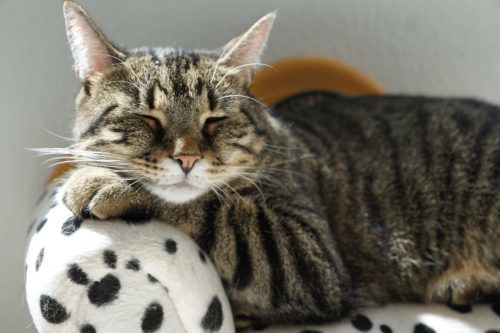Managing Feline Acne
Acne may be most common with teenagers, but many cats also develop this skin condition on the chin and lips. Fortunately, feline acne is usually minor and easy to treat.

Brandi Miller, a veterinary student at the Texas A&M College of Veterinary Medicine & Biomedical Sciences, has advice for managing cat acne and avoiding infections.
Cat acne can occur for many reasons, though the specific cause is usually unknown. Typically, the hair follicles on the chin produce too much oil, causing lesions and other bumps.
“The severity and painfulness of the lesions vary,” Miller said. “Most commonly, owners will see comedones, or ‘blackheads,’ on the chin and lips, and the cat may be itchy and want to rub its chin on furniture.”
Though this condition sounds rather unpleasant, it really is no worse than an average case of human acne. Miller said feline acne tends to need lifelong management but is usually treatable with over-the-counter medications.
“This condition is often cosmetic and does not affect the quality of life of the animal, as long as there is no infection,” Miller said. “Daily topical wipes, gels, and shampoos may help manage the lesions, but it is important to avoid alcohol and peroxide-based products, as these may be irritating to the skin and make matters worse.”
Miller said that human acne medicines should also be avoided, as they can be very harmful to animals. Sometimes one of the best treatment options is simply cleaning the cat’s chin on a regular basis.
“Popping zits is the absolute worst thing you can do—it causes a lot of pain and irritation, disrupts the structure of the hair follicle, and can spread the infection to other parts of the chin,” she said.
Miller recommends being careful when treating cats, as some may try to bite and scratch if they are in pain.
Consulting with your veterinarian is always recommended, because while feline acne is usually minor, it can become a larger issue if infections occur. Infected lesions can develop into painful bruises if left untreated.
“We don’t always know why this occurs,” Miller said. “However, plastic food dishes tend to harbor microbes, so we recommend that owners switch to metallic dishes and clean them daily.”
If a cat is prone to infections, its veterinarian may want to test for other skin conditions or parasites that could be causing the acne.
Treatment for feline acne can easily be incorporated into a daily routine, and usually takes only a minute or two. If properly cared for, cats with acne should be able to live the same pain-free life as any other cat.
Pet Talk is a service of the College of Veterinary Medicine & Biomedical Sciences, Texas A&M University. Stories can be viewed on the web at vetmed.tamu.edu/pet-talk. Suggestions for future topics may be directed to editor@cvm.tamu.edu.


